Early American Luxury at 2022 Old Car Festival

Banners with vintage Lincoln artwork welcomed visitors to the 2022 Old Car Festival at Greenfield Village. / Photo by RuAnne Phillips
We observed a beloved late-summer tradition September 10–11, 2022, with Old Car Festival, our annual celebration of automobiles built between the 1890s and 1932. First held in 1951, Old Car Festival is the longest-running antique automobile show in the United States. (Though we should probably put an asterisk on that, thanks to 2020, when Old Car Festival—like most events—was canceled.)
Luxury was often synonymous with a higher cylinder count. Cadillac delivered with this 1915 V-8 touring car. / Photo by Matt Anderson
Each year, we turn our spotlight on a special make, model, individual, or theme. February 2022 brought the 100th anniversary of Ford Motor Company’s acquisition of Lincoln Motor Company, so it seemed fitting to feature the broader subject of “Early American Luxury.” (We’d already celebrated Lincoln specifically at this year’s Motor Muster.) Certainly, this theme includes Lincoln, but it also encompasses names like Packard, Cadillac, LaSalle, Pierce-Arrow, and Peerless. These are the marques that defined the very term “luxury car” in the early decades of the 20th century.
Detroit Central Market housed a selection of luxury vehicles from show participants and from The Henry Ford’s own collection. / Photo by Matt Anderson
This year was our first opportunity to incorporate the Detroit Central Market building into Old Car Festival activities. We took advantage of the spacious new structure to show select upmarket American cars drawn from show participants and from The Henry Ford’s own collection. Among the museum’s cars on view were a 1915 Cadillac Type 51 touring car, representing the first mass-produced V-8 automobile, and a 1923 Lincoln Model L touring car that once belonged to Thomas Edison. We also showed our 1922 Detroit Electric coupe. The little coupe might not have seemed so impressive alongside the big touring cars, but there was a time when electric automobiles were purposely marketed to well-to-do women.
This 1915 Packard Twin Six (Packard’s term for its V-12 engine) embodies our “Early American Luxury” theme. / Photo by Matt Anderson
Several magnificent participant cars rounded out our Central Market display. From Packard, we had a 1915 Twin Six touring car and a 1927 Series 626 sedan. From Franklin, we had a 1931 Series 151 sedan. Auburn—part of E.L. Cord’s Auburn-Cord-Duesenberg empire—was represented by a pair of beautiful 1929 models, including a cabriolet and one of the company’s beloved boat-tail speedsters. Our special exhibit wasn’t limited to exclusive marques. Luxury cars for customers of (relatively) more modest means were represented by a 1928 Studebaker President sedan and a 1930 LaSalle coupe.
Model T cars, wagons and trucks were everywhere at Old Car Festival, including this 1924 depot hack parked near Sarah Jordan Boarding House. / Photo by RuAnne Phillips
We had more than 730 vehicles registered for this year’s show. Automobiles, station wagons, trucks, bicycles, and even a few military vehicles were spread throughout Greenfield Village over the weekend. Visitors could enjoy the sights and sounds of a 1910s ragtime street fair along Washington Boulevard. They could attend a 1920s-era community garden party near Ackley Covered Bridge. They could watch the Canadian Model T assembly team put together a Ford automobile in mere minutes. Or they could hear about wartime struggles on the Western Front outside Cotswold Cottage. At the Ford Home, near the village entrance, Old Car Festival visitors could take in an exhibition of tractors and internal-combustion engines that took some of the backbreaking labor out of early-20th-century farming. For festival participants in a matrimonial mood, our friends at Hagerty arranged a Drive-Thru Vow Renewals experience. Registered show-car owners could drive their antique vehicles past the makeshift altar in front of Edison Illuminating Company’s Station A and “re-light” their nuptials.
Martha-Mary Chapel provided an inspiring backdrop for cars on the Village Green. It also housed a series of special programs throughout the weekend. / Photo by RuAnne Phillips
Speaking of altars, Martha-Mary Chapel hosted several programs and presentations during Old Car Festival. Tom Cotter, author and host of the popular web series Barn Find Hunter, presented twice during the weekend. On Saturday, he went behind the scenes of his car-seeking show with “A Barn-Finding Life.” On Sunday, Cotter recalled the 3,000-mile journey chronicled in his book Ford Model T Coast to Coast. On both days, longtime festival participant Daniel Hershberger discussed early auto touring and roadside camping. Hershberger dedicated his talks to the memory of Randy Mason, a former curator of transportation at The Henry Ford who passed away earlier this year. Also on both days, historian Joseph Boggs looked at the fascinating relationship between automobiles and 1920s Prohibition. Cars factored into both sides of the equation—used by rumrunners and law enforcement officers alike.
Of special interest were two panel discussions on early American luxury cars, held on Saturday and Sunday. Through the generous support of the Margaret Dunning Foundation, we brought together three experts in the field: Bob Casey, retired curator of transportation at The Henry Ford; David Schultz, president of the Lincoln Owners Club; and Matt Short, former curator at the Auburn-Cord-Duesenberg Automobile Museum and former director of America’s Packard Museum. Our panelists discussed the innovators, manufacturers, and automobiles that defined luxury motoring into the 1930s. Their Sunday session was livestreamed and can be viewed here on The Henry Ford’s Facebook page.
Select participating vehicles at Old Car Festival were judged for various class awards. From those winners, one grand champion was selected each day. / Photo by RuAnne Phillips
Visitors may not be aware of a special distinction (apart from chronology) that separates Old Car Festival from our Motor Muster show. Participants at Old Car Festival can choose to have their vehicles judged by a team of vintage-automobile experts. The judges determine Vehicle Class Awards based on authenticity, quality of the restoration work, and care with which each car is maintained. First-, second-, and third-place prizes are awarded in 11 different classes. One overall Grand Champion is selected on each day of the festival. Additionally, two Curator’s Choice Awards are presented to unrestored vehicles, and guests and participants are invited to vote for their favorites in the People’s Choice Awards. The full list of our 2022 award winners may be viewed here.
Old Car Festival includes trucks, too. Commercial vehicles line Christie Street during the event. / Photo by RuAnne Phillips
Great crowds, good weather, and impressive vehicles made for a perfect show in 2022. While it’s always hard to say goodbye to summer, Old Car Festival is certainly a fine way to do it. We look forward to next year’s event already.
Matt Anderson is Curator of Transportation at The Henry Ford.
Michigan, Dearborn, 21st century, 2020s, Old Car Festival, luxury cars, Greenfield Village, events, cars, car shows, by Matt Anderson
Barney Korn: Tether Car Craftsman

Barney Korn’s work is featured in The Henry Ford’s exhibit Driven to Win: Racing in America. / Photo by Matt Anderson
In the 1930s and 1940s, race fans who didn’t have the budget or the bravery for full-size auto racing could find big thrills in small scale through the world of tether cars. These gas-powered model cars were raced by adults in organized competition. The models either raced against the clock, running in circles while tethered to a pole, or they raced against each other on a scaled-down board track fitted with guide rails.
The fastest tether cars topped 100 miles per hour—real miles, not scale miles—which explains another name given to them: spindizzies. (Imagine watching a little car zooming around a pole and the name makes perfect sense.) Though they look like toys, these models could be expensive. By the time you bought the car, the engine, the tools, and the accessories, you could be looking at more than $100—at a time when you could by a Ford DeLuxe Convertible for well under $1,000. At the hobby’s peak, some 25 major manufacturers and hundreds of individual builders produced tether cars. But few makers matched the skill and craftsmanship of Barney Korn.
Barney Korn’s skill was apparent from his high school days, as when he built this working engine in shop class. / THF160779
Bernard Barney Korn was born in Los Angles on April 24, 1903. He showed his modeling talents at an early age, building an elaborate water-cooled model engine as a project for his high school shop class. After high school, Korn honed his skills in part by working as a machinist for aviation innovator Howard Hughes, whom he joined in 1924.
One of Barney Korn’s “Indianapolis” models, with the hood removed to expose the single-cylinder gas engine. / THF157084
As tether cars became more popular, Barney Korn joined the booming business and formed B.B. Korn Specialty Manufacturing Company in 1939. His first production model, the “Meteor,” was also his rarest. Only 18 examples are known to have been made. The following year, Korn began production of his best-known and, many would say, best-looking model: the “Indianapolis.” Based on real Indianapolis 500 race cars of the time, Korn’s “Indianapolis” was handsome and well proportioned. It was a big model, with an overall length over 20 inches. Many were also exceptionally detailed. The “Liberty Special” car even had a working compass in its dashboard! But the “Indianapolis” was rare too. It’s believed that Korn produced fewer than 70 examples in total. Most featured rear-wheel drive trains and aluminum bodies, though a few had lightweight magnesium bodies. When materials were restricted during World War II, Korn mixed and matched aluminum and magnesium components as needed.
Korn’s working dynamometer measured engine performance in his model cars. / THF159749
Barney Korn used precision tools, molds, and patterns to build his model cars. In a particularly impressive feat, Korn even built a working dynamometer to test his cars’ performance. Like full-size dynamometers, Korn’s version was basically a treadmill for engines. It allowed a model car’s drive wheels to spin while the car itself remained stationary. Korn’s dyno measured the power and torque of the .60-cubic inch engine as it delivered power to the wheels. The little dynamometer was even adjustable to accommodate both front and rear-wheel drive models.
This unfinished Korn “Indianapolis 29” kit would have appealed to the budget-conscious tether car buyer. / THF162913
The B.B. Korn Manufacturing Company provided a few options for budget-conscious buyers. Instead of a standard “Indianapolis” model, they could purchase one of Korn’s “Indianapolis 29” cars. Everything about the “29” series was smaller—from the .29-cubic inch engines (source of the name), to the dimensions, to the all-important price tags. Those wanting to save even more could opt for an unassembled “Indianapolis 29” kit rather than a fully assembled car. With the kit, it was up to the buyer to finish rough edges on the balsa wood body, and to source an engine separately.
Barney Korn’s tether cars were beautifully made and carefully detailed, but that quality came at a price—in dollars and in performance. Korn’s models were too expensive for amateur hobbyists and too slow for serious racers. Poor sales made the B.B. Korn Manufacturing Company unsustainable, and it closed just a few years after it opened.
Barney Korn went on to a career in modelmaking for special effects work in films. His detailed miniatures can be seen in movies like To Please a Lady, a 1950 racing melodrama staring Clark Gable and Barbara Stanwyck, and Moby Dick, the 1956 adaptation of Herman Melville’s novel directed by John Huston. In the early 1980s, Korn even built a few improved versions of his original tether car designs.
Barney Korn died in Los Angeles on October 23, 1996, but his craftsmanship survives. Replicas of Korn’s models are readily available today, and originals are highly prized by collectors. It’s a proud legacy for a talented artist who some regard as the Leonardo da Vinci of the tether car hobby.
Explore Further
“Barney Korn: Tether Car Craftsman” expert set
“Tether Cars: Big Thrills in Small Scale” expert set
Driven to Win: Racing in America exhibit information
Artifacts related to tether cars in our Digital Collections
Matt Anderson is Curator of Transportation at The Henry Ford.
Additional Readings:
- 2016 Le Mans Class-winning Ford GT Race Car, On Loan from Ford Motor Company
- 1901 Ford "Sweepstakes" Race Car
- 1902 Ford "999" Race Car, Built by Henry Ford
- 1906 Locomobile "Old 16" Race Car
engineering, engines, making, Henry Ford Museum, Driven to Win, toys and games, by Matt Anderson, cars, racing
Horse Power

Detail, 1882 advertisement showing a three-horse tread power in use. / THF277170
How much horsepower really comes from a horse? While the answer to this may seem obvious, it is complicated. The most complete answers start out with "it depends."
Much of farming is strenuous, tedious, repetitive work. For American farmers, chronic labor shortages made the effort of farm work even more taxing, so they looked for ways to get farm work done with less manpower. Horses and oxen were the main source of power, used for centuries for plowing. Improved farm machinery throughout the 1800s added the power of horses to other activities such as planting, cultivating, and, eventually, mowing and harvesting. Farmers understood the effort required for these tasks in terms of the number of horses needed to pull the equipment, such as one horse for a cultivator, and three or more for a harvester or large plow. Applying the power of horses to farm work helped to steadily increase the productivity of American farms throughout the 1800s.
This 1854 engraving depicted the centuries-old practice of plowing with horses. Throughout the 1800s, farmers increasingly used horses or oxen for other work as well, including planting, cultivating, mowing, and harvesting. / THF118302
Yet horsepower as a measure of power pre-dates the mechanization of the farm. It was developed by James Watt in the 1780s as a way to measure the output of a steam engine. Horsepower was based on his observations of how much work a horse could do in a normal ten-hour day, pulling the sweep arms of the horse-powered pumps that were used to remove water from mines. This worked out to 33,000 foot-pounds per minute, or the effort required to raise 33,000 pounds of water by one foot in one minute.

An 1886 trade catalog depicted Russell & Co.’s “New Massillon” grain thresher powered by both a steam traction engine and a horse-driven sweep power. / THF627487, THF627489
As farmers mechanized barn or farmyard work like threshing, winnowing, corn shelling, and corn grinding, they began to use stationary power sources—either treadmills and sweeps powered by horses, or steam engines. Here, the agricultural idea of horsepower and the industrial idea of horsepower bumped heads. For example, the portable steam engine pictured just below is rated at ten horsepower. It could be used to run the same piece of farm equipment as the two-horse tread power depicted below the steam engine, which used, well, two horses. Some farmers came to use a rule of thumb for farm equipment, calculating that one horse was worth about three horsepower in an engine. Why is this?

This ten-horsepower steam engine (top) could power the same piece of farm equipment as a two-horse tread power (bottom). / THF92184, THF32303
Engine horsepower ratings (and there are many varieties of these) are typically overestimated because they are often calculations of the power delivered to the machine—not how much actually reaches its "business end." For example, they do not account for power losses that occur between the piston and whatever the piston is driving—which can be more like 70% to 90% of the rated horsepower. In addition, those measures are made at the ideal engine speed.
On the other hand, numerous studies have shown that peak horsepower for a horse (sustainable for a few seconds) is as high as 12-15 horsepower. This is based on calculated estimates, as well as observed estimates (recorded in a 1925 study of the Iowa State Fair's horse pull). Over the course of a ten-hour workday, however, the average output of a horse is closer to one horsepower—which coincides with James Watt's original way of describing horsepower.
So how much horsepower comes from a horse? As we see, it depends. If we measure it in an optimal way, as we do with engines, it is as high as 15 horsepower. If we measure it as James Watt did—over the course of a long 10-hour day, horses walking in a circle—it gets down to about one horsepower. Nineteenth-century farmers quickly learned that if they were buying an engine for a task horses had previously performed, they needed an engine rated for three horsepower for every horse they had used for the task.
This post by Jim McCabe, former Collections Manager and Curator at The Henry Ford, originally ran as part of our Pic of the Month series in May 2007. It was updated for the blog by Saige Jedele, Associate Curator, Digital Content.
Additional Readings:
- Microscope Used by George Washington Carver, circa 1900
- Bringing in the Beans: Harvesting a New Commodity
- As Ye Sow So Shall Ye Reap: The Bickford & Huffman Grain Drill
- Oliver Chilled Cast Iron Plow, circa 189
engines, by Saige Jedele, by Jim McCabe, power, agriculture, farms and farming, farming equipment, farm animals
Celebrating the National Historic Vehicle Register

America’s car culture is a subject for music, movies, and postcards—and for serious study and preservation. / THF104062
There’s an exciting new changing exhibit in Henry Ford Museum of American Innovation. In partnership with our friends at the Hagerty Drivers Foundation, we’re spotlighting some of the nation’s most significant automobiles and trucks. Some of these vehicles introduced new ideas in engineering or design, others found glory on the race track, and a few lit up the silver screen. In all cases, these vehicles left a mark on American history important enough to earn them a place on the National Historic Vehicle Register.
We inaugurate this collaborative display with a car from the world of popular culture. For those of us who were teens in the 1980s, the movies of writer-director John Hughes were inescapable. Films like Sixteen Candles, The Breakfast Club, Weird Science, and Pretty in Pink captured the Reagan-era teenage zeitgeist—and timeless teenage angst—to a T. But for self-styled Gen-X slackers, one film in the Hughes catalog stands above the rest: Ferris Bueller’s Day Off.
There’s probably no need to summarize the well-known plot (see here if you disagree). Suffice it to say, high school senior Ferris (Matthew Broderick) convinces best friend Cameron (Alan Ruck) and girlfriend Sloane (Mia Sara) to join him on his own personal skip day through Chicago. The plot really gets rolling, so to speak, when Ferris convinces Cameron to let them take his father’s 1961 Ferrari 250 GT California on their adventures. It doesn’t end well. The Ferrari becomes the target of Cameron’s longstanding anger with his father, and its accidental destruction forces some serious interpersonal growth.
This (genuine) 1958 Ferrari 250 GT California was part of Henry Ford Museum’s 1965 Sports Cars in Review exhibit. / THF139028
We’re delighted to be able to exhibit that Ferrari. Well, not that Ferrari… the one that got destroyed. For that matter, what we’re showing isn’t even a Ferrari. It’s a 1985 Modena Spyder California—an authentic-looking replica built by Modena Design & Development in El Cajon, California. It’s one of three Modena replicas used in shooting the movie. (Even in the mid-1980s, a genuine Ferrari 250 GT was too valuable to risk in film work.) This beloved pop-culture car is a playful way to kick off our celebration of a serious project: the National Historic Vehicle Register.
The National Historic Vehicle Register has its roots in the Historic American Engineering Record (HAER). Established jointly in 1969 by the National Park Service, the American Society of Civil Engineers, and the Library of Congress, HAER documents significant sites and structures associated with America’s engineering and industrial history. According to established HAER guidelines, nominated structures are documented with written reports, photographs, and technical drawings. These materials are then deposited in the Library of Congress. Generally, a listing in the HAER does not, in itself, protect a structure from possible demolition. It does, however, “preserve” that structure for the future via HAER’s extensive documentary materials.
HAER has documented buildings, bridges, and even airplanes, but it’s never documented cars. Recognizing the need for some similar mechanism to record significant automobiles and trucks, the Historic Vehicle Association (HVA) was formed in 2009. Modeling itself on HAER, the HVA had four founding principles:
- To document and recognize significant vehicles in a national register
- To establish and share best practices for the care and preservation of significant vehicles
- To promote the historical and cultural importance of motor vehicles
- To protect automotive history through affiliations with museums and academic institutions, through educational programs, and through support of relevant legislation
The Historic Vehicle Association, in collaboration with the U.S. Department of the Interior, established the National Historic Vehicle Register (NHVR) in 2013 and, in January 2014, it added the first car to its list. HVA selected a 1964 Shelby Cobra Daytona Coupe, one of six built by Carroll Shelby and his Shelby American team to compete in sports car races. Apart from Mr. Shelby himself, the Cobra Daytona Coupe was also developed with legendary racing figures like Pete Brock, Ken Miles, and Phil Remington.
CSX2287, the first Shelby Cobra Daytona Coupe, won the 12 Hours of Sebring in 1964. Fifty years later, it became the first entry on the National Historic Vehicle Register. / THF130368
We should pause to note that, of necessity, the National Historic Vehicle Register contains individual cars. The register does not list the Cobra Daytona Coupe as a model. Rather, it specifically includes chassis number CSX2287—the first of the six built, and the only one built completely at Shelby American’s Venice, California, shop. CSX2287 won the GT class at the 1964 Sebring 12-Hour race, competing as number 10, with drivers Dave MacDonald and Bob Holbert. The car later set 27 national and international land speed records at the Bonneville Salt Flats, with Craig Breedlove at the wheel. CSX2287 is now in the collections of the Simeone Foundation Automotive Museum in Philadelphia, Pennsylvania.
Following its selection, the Cobra Daytona Coupe—like all subsequent vehicles on the register—was thoroughly documented for the NHRV. Specialists researched the car through written documents and spoken interviews, they photographed it from multiple angles, and they measured the car using sophisticated laser scanners. (You can learn more about the scanning process in this clip from The Henry Ford’s Innovation Nation.) The resulting materials were then sent to the Library of Congress for long-term preservation.
The Historic Vehicle Association was founded with philanthropic support from Hagerty, the world’s largest specialist insurance provider for historic vehicles. In more recent years, the work of the HVA has been folded into the Hagerty Drivers Foundation, which manages the National Historic Vehicle Register with the U.S. Department of the Interior.
The Marmon Wasp driven by Ray Harroun, winner of the 1911 Indianapolis 500. / THF229391
To date, more than 30 vehicles have been added to the National Historic Vehicle Register. There are celebrated race cars like the 1907 Thomas Flyer that won the 1908 New York to Paris Automobile Race, the 1911 Marmon Wasp that won the first Indy 500, and one of NASCAR’s “Fabulous Hudson Hornets” driven by Herb Thomas.
Volkswagen’s groundbreaking Type 2 Transporter is represented on the NHVR by a van that served a higher purpose: supporting Black Americans in the Civil Rights Movement. / THF105564
There are vehicles that participated in large national events, like a 1918 Cadillac employed by the U.S. Army in World War I, or a 1966 Volkswagen Transporter used in humanitarian efforts supporting Black Americans on Johns Island, South Carolina, during the Civil Rights Movement, or a 1969 Chevrolet Corvette driven by Apollo astronaut Alan Bean, who landed on the Moon in November 1969.
The 1964 Chevrolet Impala lowrider is a car culture icon, illustrated by this remote-controlled model. / THF151539
The wide world of American car culture is wonderfully represented by a 1932 Ford V-8 hot rod built by Bob McGee, a 1951 Mercury Coupe modified for Masato Hirohata by “King of Kustomizers” George Barris, and the pioneering 1964 Chevrolet Impala lowrider “Gypsy Rose,” customized by Jesse Valadez.
Preston Tucker’s 1948 Tucker 48 made a mark in life and on screen. / THF135047
The register doesn’t overlook the automobile’s contributions to popular culture. Apart from the replica Ferrari used in Ferris Bueller’s Day Off, the list includes a 1968 Ford Mustang driven by Steve McQueen during the influential car chase in Bullitt, and a 1981 DeLorean DMC-12 that carried Michael J. Fox’s Marty McFly to 1955 before returning him back to the future. Preston Tucker’s 1947 Tucker 48 prototype is something of a movie car too. Yes, it inspired a real-life production vehicle, but it also inspired the 1988 film Tucker: The Man and His Dream, starring Jeff Bridges.
The 15 Millionth Ford Model T traveled from Greenfield Village to the National Mall in April 2018, after it was added to the NHVR. / Photo courtesy Hagerty Drivers Foundation
Some of you may be wondering if anything from The Henry Ford’s collections is listed on the National Historic Vehicle Register. I’m happy to report that, yes, we are represented by (what else) a Ford Model T added to the list in 2018. It’s not just any T, of course, but the 15 Millionth Ford Model T, which was the ceremonial “last” Model T built before Ford ended production in favor of the 1928–1931 Model A. Like most of the vehicles added to the register, our 15 Millionth Model T traveled to Washington, D.C., where it was displayed on the National Mall—to honor the car, but also to draw attention to the NHVR and the importance of preserving America’s automotive heritage. The NHVR research team also produced a 23-minute documentary on the Ford Model T and its enormous influence.
The register continues to grow. Likewise, The Henry Ford will continue to display a rotating selection of register cars in the years ahead. It’s a fun way to celebrate America’s car culture, but it’s also an opportunity to recognize the important and ongoing work of the National Historic Vehicle Register.
Matt Anderson is Curator of Transportation at The Henry Ford.
Model Ts, race cars, racing, popular culture, movies, by Matt Anderson, Henry Ford Museum, cars
The Scottie Dog: Icon of an Age
During the 1930s and 1940s, Scottish Terriers, or “Scotties,” popped up all over popular culture, from jewelry to ceramics to greeting cards. I've found various types of Scottie memorabilia in The Henry Ford's collections of this period. The question is, why were Scotties so popular?
According to the American Kennel Club, Scottish Terriers first became popular in America in the early 20th century, with the “Golden Age” arriving in the 1930s. This may be due to the personality of Scotties. The American Kennel Club references this description of the Scottish Terrier’s temperament: “Contented in his ways, conscious of the affection he bears to master or mistress, he regards life philosophically, takes the best when he can get it, makes the best when he cannot.”
Of course, the 1930s represents one of the most desperate economic periods in American history: the Great Depression. It makes perfect sense that Americans loved the spirited Scottie during this dark time.
Also, celebrities as diverse as Bette Davis, Dorothy Parker, Charles Lindbergh and Anne Morrow Lindbergh, and Humphrey Bogart adopted Scotties and helped make them popular—both as pets and on memorabilia.
Some of the most common places that they appear are in Christmas cards.
Christmas Card, "A Merry Christmas," 1933 / THF36815
This card shows a pair of mischievous Scotties, one of whom shows us a Christmas stocking with a puppet tumbling out of it.
"Scottie" (Scottish Terrier) Napkin Rings, 1930-1950 / THF189764
Plastics were used for inexpensive items such as these adorable napkin rings, likely purchased at a five-and-ten-cent store. They would have brightened up a Depression-era dining room table.
"Scottie Dog" Cigarette Holder and Ash Trays, 1935-1940 / THF169674
This inexpensive, yet fashionable, ceramic cigarette set, like the napkin rings, was likely retailed at a five-and-ten-cent store. It would have been a novelty or conversation piece in a middle-class living room.
Fala: The Most Famous Presidential Pet

President Franklin Delano Roosevelt with Fala, 1940 / Photo from the Franklin D. Roosevelt Presidential Library & Museum
The photograph above shows President Franklin Delano Roosevelt with his new Scottish Terrier, Fala, a gift from Roosevelt’s cousin, Margaret “Daisy” Suckley. Was Roosevelt aware of the popularity of Scotties, or was it just serendipity? Probably a little of both. Fala was named by Roosevelt after a Scottish ancestor, the “outlaw” John Murray of Falahill. “Murray the Outlaw of Falahill” was soon shortened to “Fala,” and like his namesake, the Scottie's legend grew. Fala’s adorable antics soon made him popular, and perhaps beloved, by the White House press corps.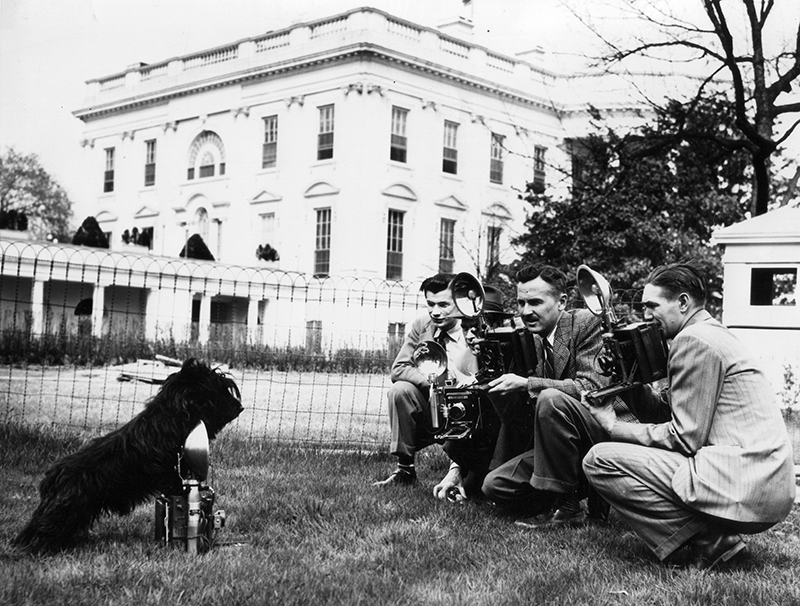
Fala “Photographing” White House Photographers, 1942 / Photo from the Franklin D. Roosevelt Presidential Library & Museum
Fala and the Barkers for Britain Campaign
As you can see, Fala’s instant fame, plus national interest in Scottish Terriers, created a public relations bonanza. During 1941, as World War II raged in Europe, the Roosevelt administration sought to help Great Britain, the lone country in Western Europe left standing against the forces of Nazi Germany. Although the United States was officially neutral, many Americans sympathized with and sought to aid the British. They were led by the British War Relief Society, an umbrella organization based in New York City. A constituent group called “Bundles for Britain” collected clothing and money for humanitarian aid. “Barkers for Britain” was created for dog lovers, with paid memberships benefiting the Bundles group. For a fee of 50 cents, dog owners could get a tag with their dog’s name inscribed with a Barkers for Britain label. President Roosevelt volunteered Fala as president of the group, and Fala got membership tag number one.
Christmas Card, "Cheerio," 1941 / THF702390
Interior of Christmas Card, “Cheerio,” 1941 / THF702391
Dating to 1941, this Christmas card references Scottish Terriers and Britain, with “Cheerio” on the outside and “The Englands” on the inside.
Fala’s Moment of Fame in 1944
As a favorite companion, Fala was constantly by Roosevelt’s side. He traveled everywhere with the president. In the late summer of 1944, with the United States now fully engaged in World War II, Fala accompanied Roosevelt on the USS Baltimore to Hawaii, where Roosevelt met with General Douglas MacArthur and Admiral Chester Nimitz on plans to retake the Philippines and attack the Japanese mainland. The Baltimore then traveled to the Aleutian Islands off the coast of Alaska, where Roosevelt met with local leaders on asserting American control over islands that had been taken by the Japanese early in the war. The ship returned to the American mainland via Seattle, where Roosevelt and Fala took a train back to Washington, D.C.
In 1944, a presidential election year, Roosevelt was seeking an unprecedented fourth term. Republicans sought any “dirt” they could find on Roosevelt, an extremely popular Democrat and president since 1933. It is unclear how the rumor got started, but Republicans began circulating a story that Fala had been left behind in the Aleutian Islands and a destroyer had been sent from Seattle, at taxpayers’ expense, to retrieve him. Roosevelt was accused of wasting some 20 million dollars in this effort. Ever the canny politician, the president used this to his advantage. Speaking to the Teamsters Union while kicking off his reelection campaign, Roosevelt gave a speech that many say ensured his reelection. Here is an excerpt:
"These Republican leaders have not been content to make personal attacks upon me—or my wife or my sons—they now include my little dog, Fala. Unlike the members of my family, Fala resents this. When he learned that the Republican fiction writers had concocted a story that I had left him behind on an Aleutian Island and had sent a destroyer back to find him—at a cost to the taxpayer of two or three or twenty million dollars—his Scottish soul was furious! He has not been the same dog since."
Not only did Roosevelt get a positive reaction from his Teamster audience, but he was also heard on radio from coast to coast. The voting public realized that the president still had fight in him and that his feisty little dog was a great asset. As part of the Roosevelt campaign, young girls began sporting Scottie dog pins, like this one.
"Scottie" (Scottish Terrier) Pin, circa 1940 / THF30462
In a broader context, Fala started the tradition of presidential pets serving as surrogates in the political arena. Some notable examples include Richard Nixon’s famous “Checkers” speech in 1952 and Socks the cat, the pet of Chelsea Clinton, daughter of Bill Clinton, in the 1990s. Nearly every president since 1944 has attempted to promote his pets, but none have done so as deftly as Roosevelt.
Eleanor Roosevelt with Fala, 1951 / Photo from the Franklin D. Roosevelt Presidential Library & Museum
After Roosevelt’s sudden death in April of 1945, Fala lived with Eleanor Roosevelt at the family’s Hyde Park, New York, home until the dog’s own death in 1952. At Roosevelt’s memorial in Washington, D.C., the president is depicted with Fala at his side.
Franklin Delano Roosevelt Memorial, Washington, D.C., 2016 / Photograph by Ellice Engdahl
The Scottie dog is truly a reflection of American life at a difficult period, when tenacity, good spirits, and a can-do mentality helped the nation survive and ultimately prosper.
Charles Sable is Curator of Decorative Arts at The Henry Ford.
Washington DC, 1940s, 1930s, 20th century, World War II, presidents, popular culture, home life, decorative arts, by Charles Sable
Celebrating Lincoln at the 2022 Motor Muster

Lincoln was in our Motor Muster spotlight, but that didn’t mean we couldn’t enjoy this beautiful 1953 Cadillac Series 62 convertible. Perfect weather added to the show’s success. / Photo by Matt Anderson
It was a Motor Muster to remember as more than 600 cars, trucks, motorcycles, and bicycles—all dating from 1933 to 1978—gathered in Greenfield Village over the weekend of June 18–19, 2022. We couldn’t have asked for better weather, with both Saturday and Sunday boasting sunny skies and mild temperatures in the mid-70s.
It’s been a century since Ford purchased Lincoln—a perfect time to bring out two Lincoln Continentals from The Henry Ford’s collection: a 1941 convertible and a 1964 limousine. / Photo by Matt Anderson
Our spotlight this year fell on Lincoln Motor Company. One hundred years ago, on February 4, 1922, Henry and Wilfred Leland sold their struggling firm to Henry and Edsel Ford. After that shaky start, Lincoln thrived under Ford management—particularly under the leadership of Edsel Ford—and produced designs and nameplates that continue to inspire today’s enthusiasts.
Detroit Central Market featured Lincoln Continentals from every styling generation within Motor Muster’s 1933–1978 time period. / Photo by Matt Anderson
This was our first Motor Muster with the Detroit Central Market building, which opened earlier this year. We took full advantage of the beautiful structure, using it as a showcase for our Lincoln Motor Company theme. With generous assistance from some of our participants, and by drawing on The Henry Ford’s own collections, we assembled a complete set of at least one Lincoln Continental from every styling generation produced in our Motor Muster time frame of 1933 to 1978. Highlights included our 1941 Lincoln Continental convertible—a personal car of Edsel Ford who, with designer Bob Gregorie, created the original Continental—and our 1964 Lincoln Continental stretch limousine modified for Pope Paul VI. Other special vehicles included a full set of Lincoln’s top-of-the-line Mark-series Continentals representing the Mark III, VI, and V models. For good measure, we also included a couple of Continental Mark II cars—even though, strictly speaking, they’re not Lincolns.
This 1977 Ford Bronco looked just fine posed in front of the Logan County Courthouse where—speaking of Lincolns—Abraham Lincoln tried cases in the 1840s. / Photo by Matt Anderson
Our familiar decade vignettes returned for 2022. We recognized the 1930s with a re-created Civilian Conservation Corps camp, cooking demonstrations, and a wonderful selection of blues music by singer-guitarist Robert Jones. For the 1940s, we honored American efforts during World War II with a re-created wartime scrap drive and a horse-drawn milk delivery wagon—an appropriate fuel-saving measure and a reminder of days when the local dairy delivered right to your doorstep.
Outboard boat motors—and even a few boats—highlighted the “Tailfins and Two-Tones” boating display at Suwanee Lagoon. / Photo by Matt Anderson
The 1950s and 1960s had three interesting expressions at Motor Muster this year. We had our suburbia-inspired selection of vintage lawn mowers, as well as regular musical performances of ’50s hits by the Village Cruisers. New for 2022 was our “Tailfins and Two-Tones: Outboard Boating’s Golden Age” display on the banks of Suwanee Lagoon. Some of our show participants staged a selection of vintage outboard boat motors, along with a small flotilla of (trailered) motorboats exhibiting the same bright colors and tall tailfins seen on automobiles of the time.
Something truly unusual: a 1978 VAZ 21011 sedan built in the Soviet Union—but flying Ukrainian flags in support of that besieged nation. / Photo by Matt Anderson
We celebrated the 1970s with another trio of programs. Costumed participants enjoyed a 1976 Bicentennial picnic near Ackley Covered Bridge. The band Classic Gold provided mini concerts of classic rock hits at the nearby gazebo. And, at the Herschell-Spillman Carousel, the vintage band organ pumped out music of a different vintage as it played hits by ’70s Swedish pop phenom ABBA throughout the weekend.
Regular pass-in-review programs provided expert commentary on participating cars, like this 1955 Pontiac Star Chief. / Photo by Matt Anderson
As always, Motor Muster visitors could choose to walk throughout Greenfield Village to see the cars arranged in chronological groupings, or they could find a seat in the bleachers on Main Street and let the cars come to them. Our pass-in-review programs, held throughout the weekend, had participant cars parading past the reviewing stand where expert narrators provided commentary on the various vehicles—design elements, engineering achievements, and personal stories from the collectors who shared their cars with us at the show.
After a couple of unusual years, it was good to be back at a Motor Muster that felt so close to normal. We’ve missed the cars for sure, but we’ve missed the camaraderie even more. Ask any of the show’s participants—the cars might draw us into this hobby, but it’s the stories and the friendships that keep us hooked.
Matt Anderson is Curator of Transportation at The Henry Ford.
Michigan, Dearborn, 21st century, 2020s, Motor Muster, Greenfield Village, Ford Motor Company, events, cars, car shows, by Matt Anderson
The earliest form of decorative arts that fascinated Europeans was porcelain. Around the 7th or 8th century C.E., the Chinese first produced what Westerners call “hard paste” porcelain—clay that consists of a compound containing the mineral kaolin and is fired at an extremely high temperature, usually around 1400 degrees Celsius. The kaolin in the clay fused the body with the glaze on top during the firing process. The resulting vessel proved to be extremely durable, almost glass-like, and resisted chips and cracking. Should the piece break, it would be a clean break.
Western ceramics were mostly made from earthenware, usually fired at a relatively low temperature with a slip (watered-down clay) glaze or a true glaze. Both processes cover the vessel with fine particles which fuse into a glasslike layer, sealing the pores of the clay body. There are two main types of glazed earthenware. The first is covered with a transparent lead glaze, where the earthenware body to which this glaze is applied has a creamy color, known as creamware. The second type, covered with an opaque white glaze, is called tin-glazed earthenware, popularly known as majolica, faience, or delft. Both types of earthenware chipped and broke easily.
When Europeans were first exposed to Chinese porcelain in the 14th and 15th centuries, it was seen as wondrous and innovative. In addition to its glasslike qualities, the pure white color of the porcelain amazed Europeans. In the 16th and 17th centuries, Spanish, Portuguese, and Dutch traders competed to secure Chinese porcelains for the European markets. The teacup shown below is a good example of what the Europeans craved.

Teacup from Vung Tau Shipwreck, Late 17th Century / THF188797

Teacup from Vung Tau Shipwreck, Late 17th Century / THF188796
This teacup was salvaged from a shipwreck dating around 1690 in the South China Sea, about 100 miles from Vung Tau, Vietnam. During the early 1990s, thousands of porcelain items destined for the Dutch market were brought up from the wreck and sold at auction. The Henry Ford acquired this item from one of the auctions. This small cup would have been prized in the household of a wealthy European. It might even have found its way to the American colonies as a luxury item during the late 17th or early 18th centuries.
Items like this teacup provided a design source for European ceramic makers beginning in the late 17th century. Basically, they attempted to appropriate the Chinese designs in earthenware, as in the storage jar shown below.

Storage Jar, 1710-1750, Made in the Netherlands / THF190255

Storage Jar, 1710-1750, Made in the Netherlands / THF190254
What is so interesting about this piece is that the Dutch decorator is drawing Chinese figures in a Chinese inspired landscape for a European audience. Even the form, known as a ginger jar shape, is based on Chinese precedent. The only missing element here is the circular lid. This is helpful for us because the top rim, where the lid should be, shows us the chips in the glaze that occurred though use. We can see that this is not Chinese porcelain, as the dark-colored earthenware body shows through. Chips are also visible along the base. Clearly this jar was not only a prized object but was used.

Punch Bowl, 1700-1730, Made in England / THF188783

Plate, 1690-1710, Made in England / THF188779
The punch bowl and plate shown above, both made in England, attempt to copy the look of Chinese porcelains—but, like the storage jar, are made of earthenware. We could really call these the first "knock-offs" in history. They represent the beginnings of what collectors and scholars call “Chinoiserie”—the appropriation and interpretation of Chinese and East Asian design motifs by Europeans. The idea was to create the spirit of a faraway place and give the owner the cachet of owning a luxurious and expensive object. The underlying idea was to project a sense of worldliness and sophistication.

Tea Box and Cannisters, 1800-1840, Made in China for the Western Market / THF190059

Tea Caddy, 1740-1770, Made in England / THF189630
During the 17th and 18th centuries, tea from China became an important trade good, especially in England and America. Elegant Chinese lacquer boxes, complete with Chinoiserie scenes, became the rage, as did tea caddies, a necessary part of a tea set designed to safely store and dispense tea leaves.

Tea Service, 1765–1770, Made by the Worcester Porcelain Company, Shropshire, England / THF154881
In the later 18th century, tea equipment became extremely sophisticated, as the set above shows. This service uses Chinese or Chinoiserie decorative elements and combines them with the popular French Rococo decorative style to a luxurious effect. The English Worcester Porcelain Company tried to imitate Chinese porcelains with their “soft paste” porcelains, which were close approximations of the true “hard paste” Chinese wares. By 1800, the chemistry of Chinese porcelains was known in Europe—first by the Meissen firm in Germany, then later spreading out across the continent.

Western Tea Pots and Slop Bowl in Silver Next to Chinese Versions in Porcelain, Late 18th Century / THF139315
An interesting aspect of the China Trade was the production of Chinese versions of Western forms in porcelain. Western traders or agents, known as “supercargoes,” brought examples of Western wares for copy to Guangzhou (then called the port of Canton by the English). There, they presented them to their Chinese counterparts, who took these items to the porcelain factories located in Jingdezhen, then the porcelain capital of China.

“Hong” Bowl, about 1780, Made in China for the Western Market / THF190085

“Hong” Bowl, about 1780, Showing Trading Offices, Indicated by the Flags of Great Britain, the Hanseatic League (Now Germany), and Sweden / THF190086

“Hong” Bowl, about 1780, Showing the Port of Guangzhou and the Trading Office of Denmark, Indicated by the Flag / THF190088
One of the most interesting aspects of the China Trade was souvenir “Hong” bowls that showed panoramic views of offices, warehouses, and living spaces for foreign merchants in Guangzhou in the late 18th century. These were brought back to the West by supercargoes and used for serving punch at parties. Western merchants were allowed access only to the port area and needed Chinese intermediaries to send their orders to the porcelain factories inland.
In addition to porcelain tea and lacquerware, Westerners sought out luxurious Chinese silks, but relatively little else was imported to the West. One exception is the teapot shown below, made of a Chinese alloy of nickel and copper known as Paktong that resembles silver. In fact, the term “Paktong” is a corruption of the Chinese “bai tong,” meaning “white copper.”

Teapot with Stand, Made for Export, circa 1800 / THF92948
This teapot, made around 1800, was created for sale in the newly independent United States. Following the Revolutionary War, Americans were eager to establish international trade, and the lucrative China Trade was at the top of their list. This teapot would have appealed to Americans as it was executed in the fashionable Federal or Neoclassical style, which emphasized geometric forms, ovals, and cylindrical shapes.
By 1800, the China Trade began to transform. The American market broadened the China Trade, especially as the 19th century progressed and the United States grew. Also, Chinese goods were no longer viewed as unique and luxurious, as they were in the 18th century. This is partly due to the Western discovery of true or “hard paste” porcelain. The Chinese monopoly was gone. Still, Asian goods were depicted as exotic and the romanticized mystery of the Far East continued. In a second installment of this story, we will examine the transformation and role of Japanese influence on the West in the later 19th century.
Charles Sable is Curator of Decorative Arts at The Henry Ford.
Additional Readings:
- Build a Model T: Make, Build, Engineer
- The Wool Carding Machine
- Women in Industry and at Home in WWI
- The Hitchcock Chair: An American Innovation
18th century, 17th century, Europe, Asia, manufacturing, making, home life, design, decorative arts, ceramics, by Charles Sable

For decades, many Americans shared a common misperception that Indigenous people feared the geysers at Yellowstone. / THF120298
Until recently, much of the American public has shared a common misperception that few Indigenous people had ever ventured within the boundaries of what became Yellowstone National Park. Story had it that these people were afraid of the geysers, or that they felt that the hissing steam vents were signs of angry gods or evil spirits. In fact, the presence of Indigenous Americans was purposefully erased from the story of Yellowstone National Park, beginning with the first white “scientific” expedition there in 1871. This erasure, which lasted through most of the park’s history, is only recently beginning to change.
Some Indigenous people, in their pursuit of the large herds of bison to the east, created a trail that passed near what is now known as Mammoth Hot Springs. / THF120351
Archaeological evidence now indicates that as far back as 10,000 years ago, several bands of Indigenous people regularly passed through this area, primarily hunting bison, bighorn sheep, elk, and deer. In historic times, the area continued to serve as a crossroads for many Indigenous groups—including Crow, Shoshone, Bannock, Blackfoot, Nez Perce, and Flathead—who followed the Yellowstone River and other waterways through what eventually became the boundaries of the park. They tracked small buffalo herds, elk, and deer in the mountains and forests during the summer months and followed these animals to the warmer geothermal area of the Yellowstone Basin during the bitter winter months. Some of these groups crossed through the area to pursue the great herds of bison in the plains farther east, creating a trail that passed through the area now known as Mammoth Hot Springs and stretching eastward across what is known today as Lamar Valley. Early white hunters, trappers, and explorers not only followed the trails that Indigenous people created, but it is from these people that they first heard the fantastic stories of geothermal wonders in the Yellowstone Basin.
Many early photographs of the wonders of Yellowstone, like this “Grand Group” of geysers, were probably taken by William Henry Jackson, one of the people who accompanied Ferdinand Hayden on his 1871 expedition through what would become the park. / THF120369
The process of Indigenous erasure in Yellowstone began in earnest with the Hayden expedition of 1871—a large, government-funded expedition led by geologist Ferdinand Hayden to study, collect specimens in, and map out the confines of the Yellowstone “wonderland” that had been receiving so much recent attention. Hayden and members of his expedition were able to observe firsthand the places that had been described primarily in stories told by Shoshone and Bannock people—astonishing places like “The White Mountain” (which became known as Mammoth Hot Springs) and the spectacular geysers, bubbling mud pots, and hissing steam vents situated within the geothermal area of the Yellowstone Basin. As a result of this expedition, Hayden laid claim to this unique landscape on behalf of the United States government and the American people, choosing to ignore the longstanding use of the region by Indigenous people. Instead, the expedition report pointed to Yellowstone’s wonders as proof of the country’s “exceptionalism”—that is, Americans’ long-sought evidence that the United States was unique and exceptional when compared with other nations of the world.
Photo of "Sheepeater" Shoshone, William Henry Jackson, 1871. / Public domain photo from National Park Service
By the time of the Hayden Expedition, the only Indigenous people still known to inhabit the area were a by-then considered poor and lowly band of Eastern Shoshone called Sheepeaters (Tukudeka or Tukadika). A wealth of recent archaeological information has pointed to the conclusion that this band had inhabited and roamed this area for thousands of years—not the mere 200 years that early white explorers surmised (a story that then became widely accepted). These people had developed a remarkably sustainable way of life, taking advantage of the once-large population of bighorn sheep for food, clothing, blankets, tools, and bows. Early white trappers observed this band’s self-confidence, intelligence, friendliness, and willingness to trade their fine-quality hide clothing, horn bows, and obsidian arrowheads. Unfortunately, the bighorn sheep population plummeted as the result of diseases brought by white settlers’ domestic sheep. White hunters and settlers also decimated other game and polluted the streams in which these people had fished. No wonder, then, that by the 1870s white explorers of the area described these people as starving and miserable.
In 1903, this monumental stone gateway was completed to mark the north entrance to Yellowstone National Park. The words “for the benefit and enjoyment of the people,” inscribed above the arch, are taken directly from the legislation that created Yellowstone back in 1872. / THF120280
The widely publicized and highly celebrated Hayden report rapidly led to the creation of a bill to set the area aside as a national park, a “resort for all classes of people from all portions of the world,” a democratic landscape of tourism. When the question of Indigenous claims to the area under the 1868 Treaty of Fort Laramie was raised, the argument was made that the land was simply too hostile for Indigenous people to live there. Though this was not true, Hayden’s expedition report had already justified the removal of Indigenous people from the area. The bill passed easily, with the help of aggressive lobbying by the Northern Pacific Railroad and the strong desire by members of Congress to use the bill as a way to help unify a Civil War-torn nation. The Yellowstone National Park Protection Act (or, simply, the Yellowstone Act) was placed on President Ulysses S. Grant’s desk on March 1, 1872. President Grant signed it without fanfare. During the 1870s, the Sheepeaters were easily rounded up and exiled to the Wind River (Wyoming) and Fort Hall (Idaho) reservations to live with other bands of Shoshone, along with Bannock and Arapaho people. 
Early tourists typically boarded horse-drawn carriages to view the sites at Yellowstone National Park. / THF200464
When Yellowstone became a national park, no funds were allotted to administer or manage it. But an 1877 incident involving an encounter between another Indigenous group and two groups of tourists in the park changed that. The incident involved a group of Nez Perce (Nii mi’ipuu) crossing through the park in an epic flight to avoid the U.S. Army, who was pursuing them to force their removal from their ancestral homeland in eastern Oregon to a tiny reservation in Washington. This incident, which unfortunately involved violence and hostage-taking, created a national media sensation. Many personal accounts of the episode emerged afterward, with some indication that those who were involved sympathized with the plight of the Nez Perce. The Nez Perce group managed to successfully evade the army until the soldiers finally caught up with them 40 miles south of the Canadian border—in an attempt to join Sitting Bull’s Lakota band.
As a result of the widespread publicity and furor raised by this incident, Congress finally committed some money to managing the park. As tourism increased, Congress pressured Yellowstone park administrators to control the “savages” because it was assumed that they would endanger the park’s visitors. After that time, park administrators aggressively downplayed any presence of Indigenous people, not wanting the park’s well-heeled guests to risk crossing paths with them, or to even be worried that they might. By 1882, all Indigenous groups had been banned from the park.
Sheepeater Cliff was named after the only Indigenous people that lived on in public memory as having inhabited the Yellowstone area. / Photo by NPS/Jim Peaco
Once the real presence of Indigenous people had been erased from the landscape, park superintendents, railroad publicists, and tourists alike could look back—safely, nostalgically, and romantically—on the one-time presence of Indigenous people there. For example, when park administrators came across the remnants of wickiups (temporary shelters made from poles leaned and tied together, covered with brush or grass) eight miles south of Mammoth Hot Springs, they assumed these were made and used by the Sheepeaters. Since this was the only group still in the public memory as having inhabited Yellowstone, they felt that they were honoring their one-time presence by naming the natural feature near there “Sheepeater Cliff”—though this band did not live in that area and likely did not build these shelters. Once established, the perception that no Indigenous people had ever set foot inside the current boundaries of Yellowstone National Park (except for the Sheepeaters) persisted for decades.
In recent years, however, archaeologists, historians, and Indigenous activists have begun to correct the narrative of Indigenous presence and habitation on this land. In addition, administrators at Yellowstone National Park have also been making a concerted effort to elevate Indigenous voices and incorporate Indigenous knowledge systems into their research and programs (see, for example: https://roadtrippers.com/magazine/yellowstone-150-native-american-voices/ and https://www.nps.gov/yell/getinvolved/150-years-of-yellowstone.htm). Today, they recognize at least 27 distinct American tribes that have historic and present-day connections to the land and resources of the park. As champions of ecological connectivity, Indigenous people have been galvanizing action to protect Yellowstone’s wildlife, helping to relocate bison culled from the park, raising awareness on living with bears and wolves in the wider landscape, and enlightening administrators and the public on other aspects of environmental conservation related to the Yellowstone ecosystem. For the 150th anniversary of the park in 2022, administrators have been “shining a light” on Indigenous people whose past, present, and future are an essential part of Yellowstone’s story. As Cam Sholly, superintendent of Yellowstone National Park, proclaims, “This isn’t just about the last century and a half. We also want to use this anniversary to do a better job of fully recognizing many American Indian nations that lived in this area for thousands of years prior to Yellowstone becoming a park…. The engagement we’re doing now will help set a stronger foundation for collaboration well into the future.”
As erasure shifts toward inclusion—through published materials, behind-the-scenes collaboration, and public programming—the historic and present-day connections of Indigenous people to Yellowstone National Park will continue to play an important role in the park’s future.
Donna R. Braden is Senior Curator and Curator of Public Life at The Henry Ford. For recent books aimed at greater inclusion of Indigenous people in Yellowstone’s history, she recommends Saving Yellowstone: Exploration and Preservation in Reconstruction America by Megan Kate Nelson (2022) and Wonderlandscape: Yellowstone National Park and the Evolution of an American Cultural Icon by John Clayton (2017).
Wyoming, Yellowstone National Park, nature, national parks, Indigenous peoples, by Donna R. Braden, 21st century, 2020s, 19th century
OUT!: LGBTQ+ Visibility and Identity
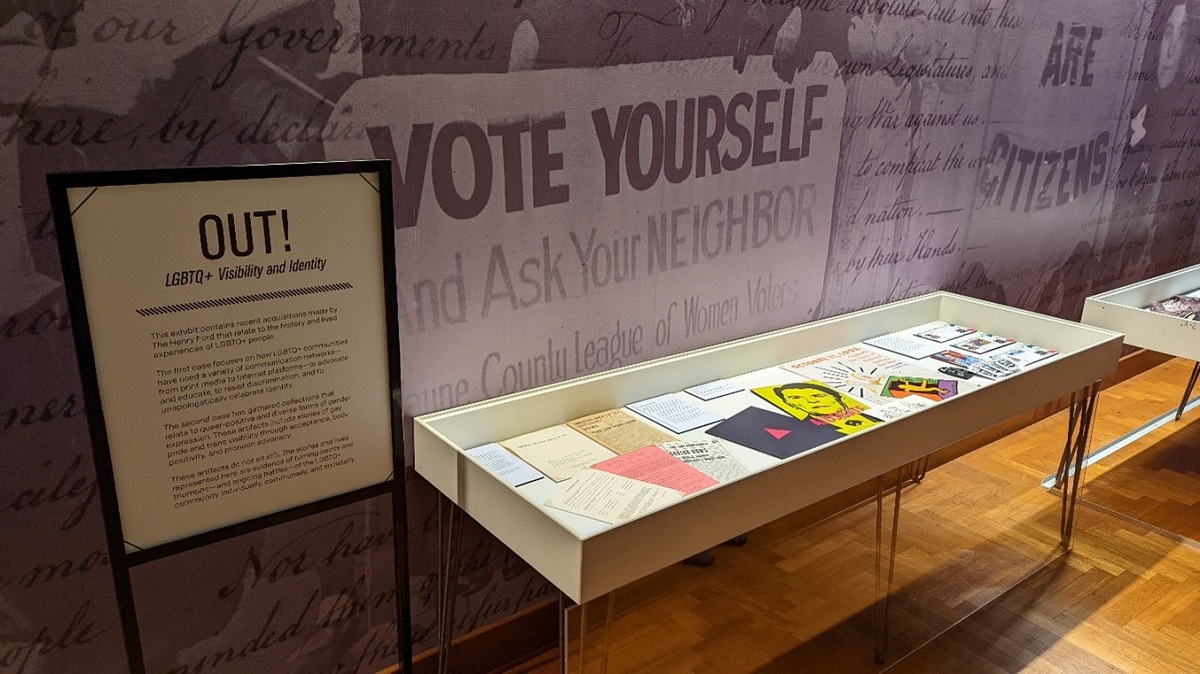
Photo by Kristen Gallerneaux/Katherine White
In 2022, The Henry Ford displayed a temporary exhibit, OUT!: LGBTQ+ Visibility and Identity, at Henry Ford Museum of American Innovation. The exhibit, co-curated by Kristen Gallerneaux and Katherine White and featuring items from The Henry Ford's collections, contained recent acquisitions that relate to the history and lived experiences of LGBTQ+ people.
The first theme explored in this exhibit was how LGBTQ+ communities have used a variety of communication networks—from print media to Internet platforms—to advocate and educate, to resist discrimination, and to unapologetically celebrate identity.
The second major theme gathered collections that relate to queer-positive and diverse forms of gender expression. These artifacts included stories of gay pride and trans visibility through acceptance, body positivity, and pronoun advocacy.
These artifacts do not sit still. The stories and lives represented in OUT!: LGBTQ+ Visibility and Identity are evidence of turning points and triumphs—and ongoing battles—of the LGBTQ+ community individually, communally, and societally.
Getting the Word Out
In the 1960s, LGBTQ+ people faced a largely unaccepting American society and legal landscape that restricted how they could express themselves. Queer bars and clubs were among the only private, “safe” spaces, for LGBTQ+ patrons but they were also easy targets for police, who harassed and arrested patrons. On June 28, 1969, New York City police raided the Stonewall Inn, a gay club in Greenwich Village. A riot ensued.
Queer bars and clubs also became sites of community and connection—even amidst persecution and harassment—and became fertile soil for the burgeoning queer liberation movement. LGBTQ+ newspapers were distributed in these spaces, broadcasting news unlikely to be shared in mainstream media. Print media like these unified queer/LGBTQ+ people in the fight for acceptance and equality through sharing manifestos, organizing protests, and recruiting members.
Today, we recognize the legacy of the Stonewall Riots as the genesis for the Pride marches that celebrate the LGBTQ+ community every June, in cities big and small across America. .jpg?sfvrsn=e6cd3601_2)
THF627212.jpg?sfvrsn=b2cd3601_2)
THF627336
These fliers were created by New York City’s chapter of The Mattachine Society, one of the oldest gay rights groups in America, in the months following the Stonewall Riot. They illustrate the urgency felt by the queer community in the wake of persistent and brutal police violence.
Raising Awareness
In the early and mid-1980s, activist collectives formed to raise awareness of HIV and AIDS. This advocacy was critical, since government and public health organizations initially refused to act or acknowledge the developing crisis. Misinformation about HIV and AIDS transmission was widespread, and so LGBTQ leaders and allies spoke up—demanding an end to negligence, access to testing, treatment options, and vetted public education about HIV prevention..jpg?sfvrsn=aacd3601_2)
THF179775.jpg?sfvrsn=9acd3601_2)
THF627370
The Silence=Death Collective’s “AIDSgate” poster condemns then-president Ronald Reagan’s lack of response to the AIDS epidemic. In 1981, the first AIDS cases in the United States; President Reagan did not recognize AIDS in a public speech until September 1985..jpg?sfvrsn=eecd3601_2)
THF627366.jpg?sfvrsn=86cd3601_2)
THF627364
Howard Cruse, author of the acclaimed graphic novel Stuck Rubber Baby, uses the slogan of the Gay Liberation Front in the top drawing above: “We’re here, we’re queer, get used to it!” The “Gay is Good” illustration mimics historical photographs of protestors at the 1969 Stonewall Uprising that were also referenced in the “Gay Liberation” poster by Su Negrin, Peter Hujar, and Suzanne Bevier.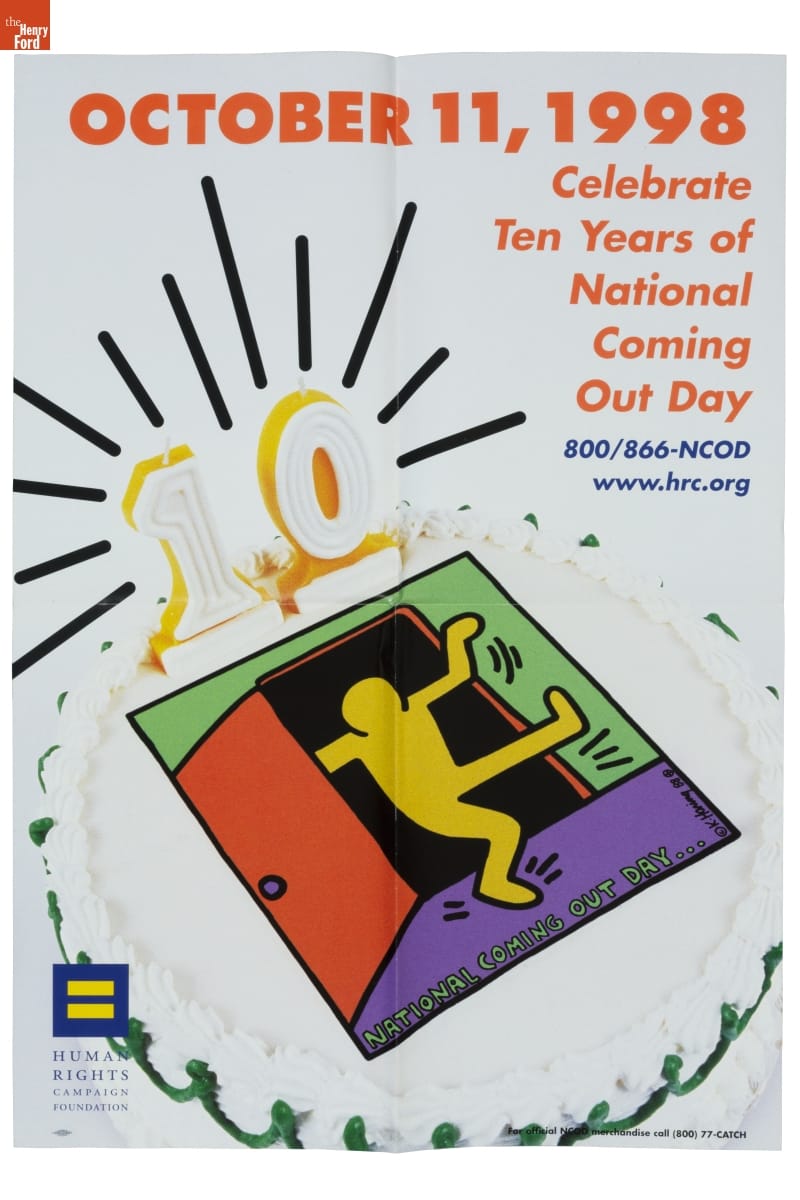
THF190487
In 1988, Richard Eichberg and Jean O’Leary founded Coming Out Day to provide resources for LGBTQ+ people wishing to publicly declare their identity. The pair believed that “coming out” would promote solidarity and acceptance while reducing homophobia. The Human Rights Campaign (an LGBTQ+ advocacy and political lobbying group) sponsors this event in the United States. This poster commemorates the 10th anniversary of the observance, which remains active in 2022. The logo of a person dancing their way out of a closet depicted on the cake on this poster references artist Keith Haring’s original NCOD logo.
Online Identity & Safe Spaces
Online platforms can act as digital “safe spaces” for LGBTQ+ community-building. Beginning with Usenet bulletin board systems in the 1980s and transitioning to LiveJournal, Twitter, and Tumblr in the 2000s, these sites can act as support networks for LGBTQ+ people—including those who live in isolated areas or in situations where openly exploring identity poses challenges AFK (away from keyboard). 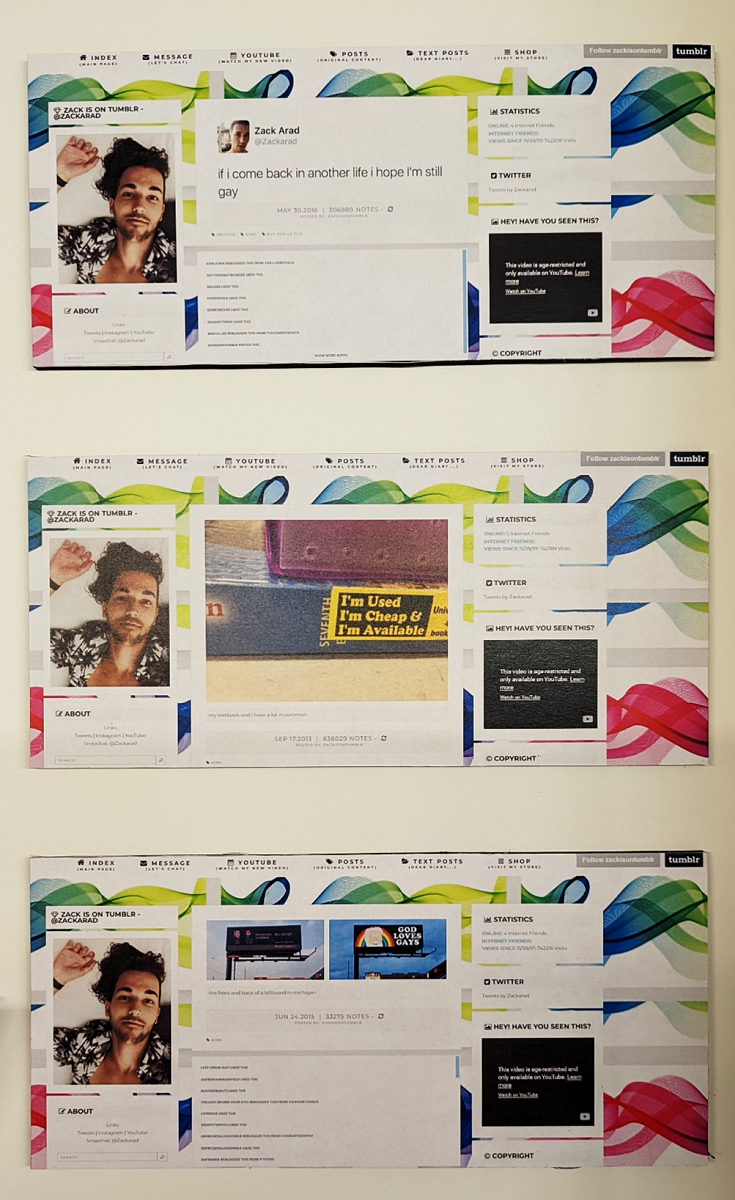
Photo by Kristen Gallerneaux/Katherine White
Zack Arad launched a microblog on July 21, 2010. Arad, who self-identifies as gay, has been active on social media since he was a teenager. His popular Tumblr blog and YouTube vlogs explore themes like gay pride, pop culture, humor, dating, and political issues.
Photo by Kristen Gallerneaux/Katherine White
This “mini-quilt” was created by Zak Foster, a textile artist who identifies as gay and has a strong online following for their work, selling one-of-a-kind upcycled quilts on Etsy. With Grace Rother, Foster also created this collection of “zines,” and distributed them online “as a love offering … to all the queer folks in the quilting community.”
Identity & Solidarity
Buttons, patches, badges, and pins are consciousness-raising, inexpensive, quick to create, and able to be distributed widely. Wearing a button can be a method of activism. When simply being “out” as LGBTQ+ means possible danger and discrimination, choosing to wear a visible symbol of queerness is a courageous act. .jpg?sfvrsn=becd3601_2)
THF189705
The cap above was worn by a member of a California-based gay motorcycle club. Among the oldest gay organizations in the United States, these clubs emphasized hypermasculinity, which appealed to many gay men who had long been stereotyped as effeminate.
Photo by Kristen Gallerneaux/Katherine White
Many of the buttons featured here use symbols or terms that were once weaponized against the LGBTQ+ community but were later reclaimed. The inverted pink triangle, for example, has its roots in the Holocaust, when Nazis forced queer people to wear a pink triangle as a form of identification and persecution. By repurposing these symbols, a shared and recognizable language of identity and solidarity is created among LGBTQ+ people and allies.
Trans Acceptance
Transgender and nonbinary people have always existed, across time and in every corner of the world—just as have gay, bisexual, lesbian, and other queer communities. But acceptance by the broader world has been difficult to achieve. Even the early leaders of the LGBTQ+ equality movement pushed the transgender community to the fringes. For many transgender and nonbinary individuals, the realization that their gender identity does not align with their assigned-at-birth gender comes long before even their own acceptance and celebration of it.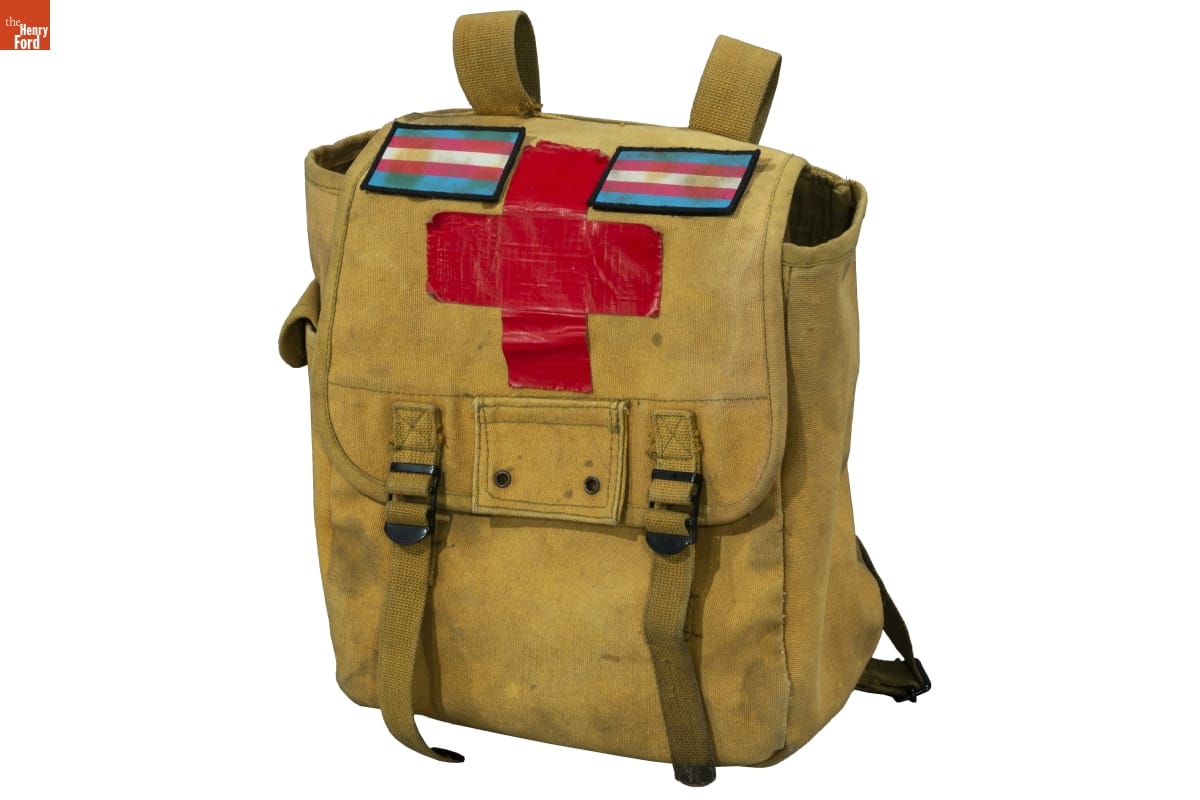
THF190453
THF611162
Miley Kirby came out publicly and applied trans flag patches to her medic bag during Detroit’s Black Lives Matter protests, which held supplies used to provide medical care to fellow protestors. Kirby is visible carrying this same bag in the center of the press photo above, published in the Detroit News during the Black Lives Matter protests of Summer 2020.
“The people I met at the [George Floyd] protest were one of the first groups of people that encouraged me to be me. They refused to let me cop out on pronouns, names, or hand-waving of my transness for others comfort. We yelled our message in the streets, why not scream your identity to the world? My time in those protests found me my voice as Miley Kirby, or at least the beginning of one.” – Miley Kirby 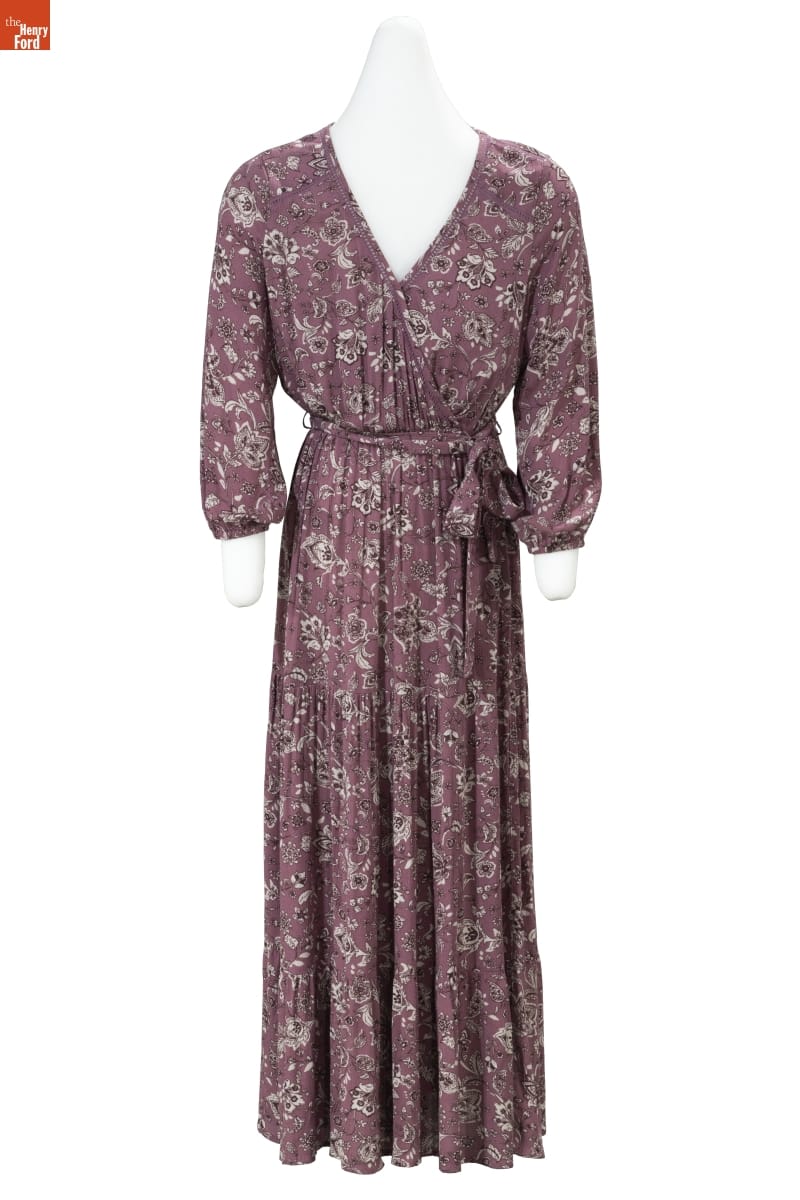
THF190458
Allie Zecivic listened to an insistent inner voice and purchased this dress, her first article of women’s clothing. It helped her to accept her gender identity as a transwoman.
“Hot Topic skinny jeans and too tight graphic tees were alright, but this was a dress. A long, flowy, spinny dress. I spent a lot of time sitting alone in my room wearing it, my heart racing and the paranoia spinning horrible outcomes in my head, but it felt right. The validation that dress brought was freeing. It was this feeling in the face of trepidation of being caught, that solidified my need for more. And such my wardrobe grew.” – Allie Zecivic 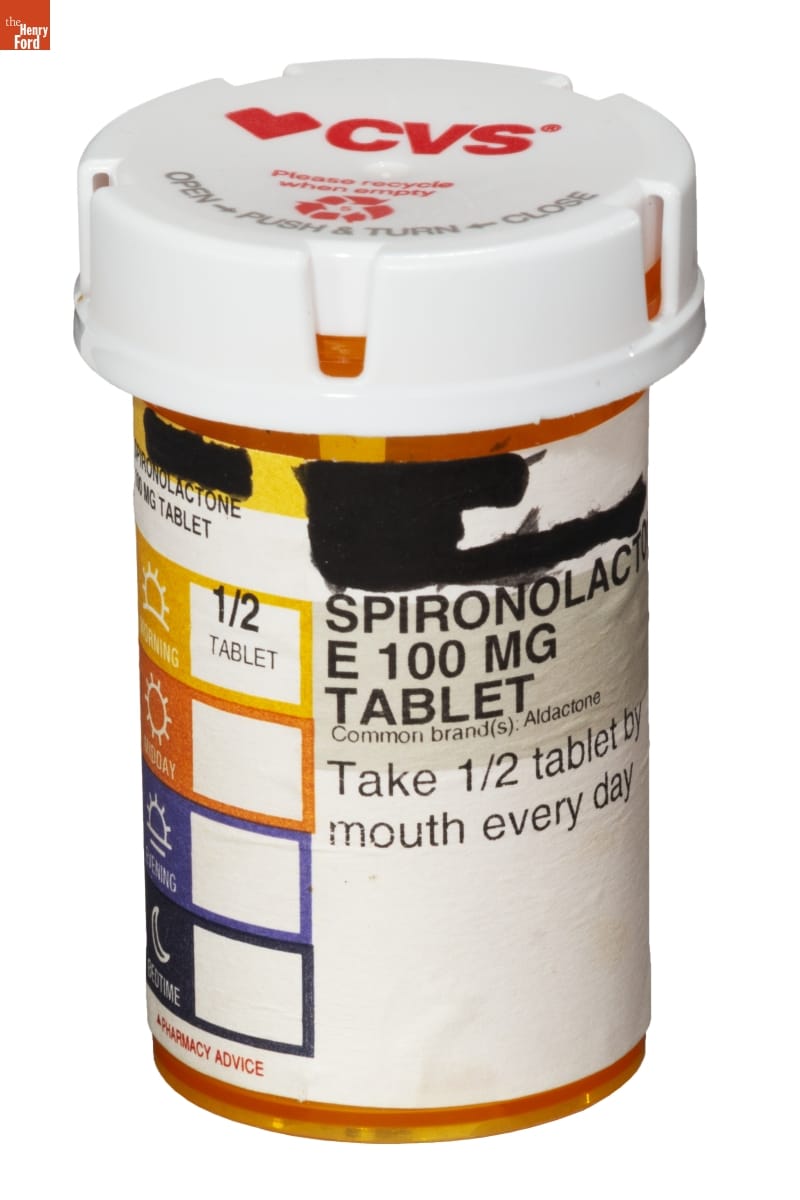
THF190456
THF190457
Laura Bowman began the medical transition to female with these hormone replacement therapy medications. She crossed out her “deadname”—the male name she was given at birth—and kept these bottles as symbols of her journey.
“Hormones don't make a transperson trans, but for many of us they are the beginning of the end. The end of the old life, and the beginning of a new experience, a new chance to be who we want to be, to make the outside fit how we feel inside. When I first picked up these pill bottles, I felt a giant weight off my chest as it felt like I was going to be able to make some progress on that person in the mirror and come to like her just a little better. The major part of that comes when you change the way you perceive yourself, but damn do the hormones help!” –Laura Bowman
Body Positive
Carrie Metz-Caporusso is an artist and tattooer who identifies as queer and non-binary. They began tattooing in 2011 and are committed to challenging traditions in tattooing culture that sometimes stigmatize LGBTQ+ and larger-bodied people. After experiencing fat shaming in the tattooing world, Carrie brainstormed a way to celebrate—rather than conceal—plus-sized body types with custom “roll flower” tattoos. These tattoos align with the body positivity movement by embracing the natural folds and creases on client’s backs or sides, which serve as a “stem” for flowers and leaves emerging from above and below.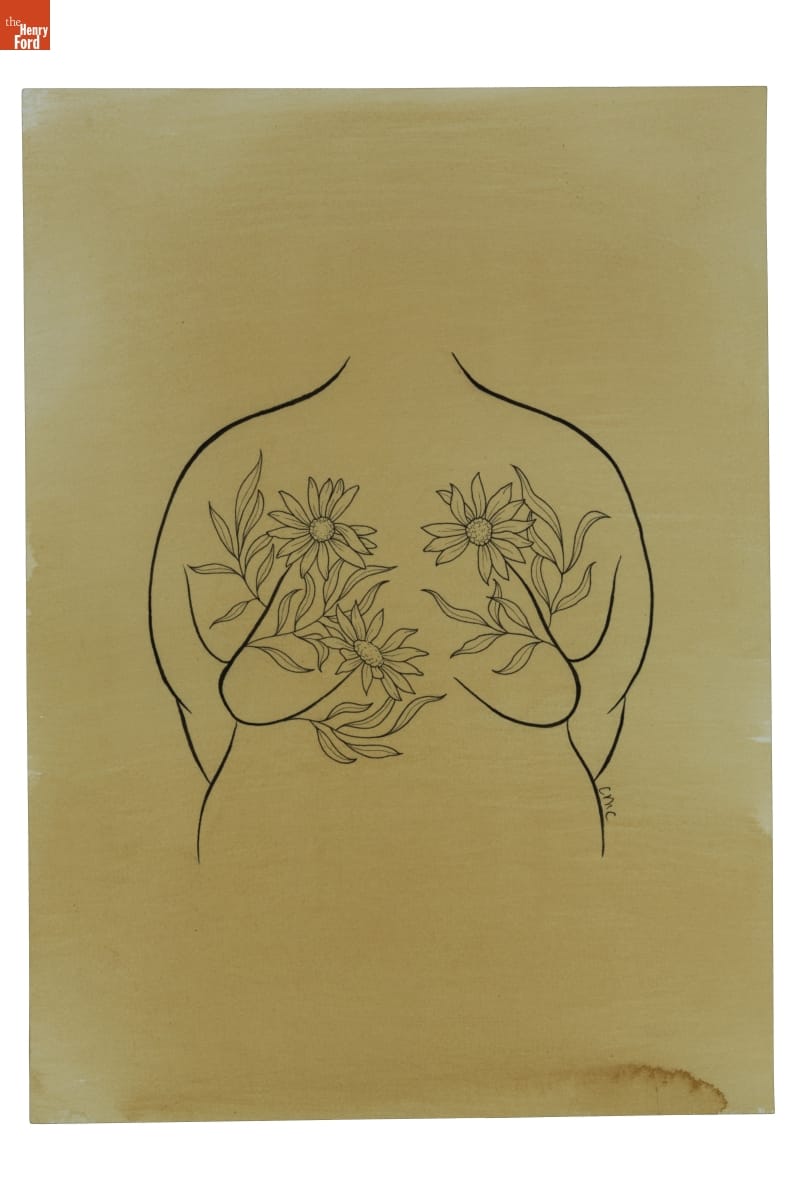
THF190488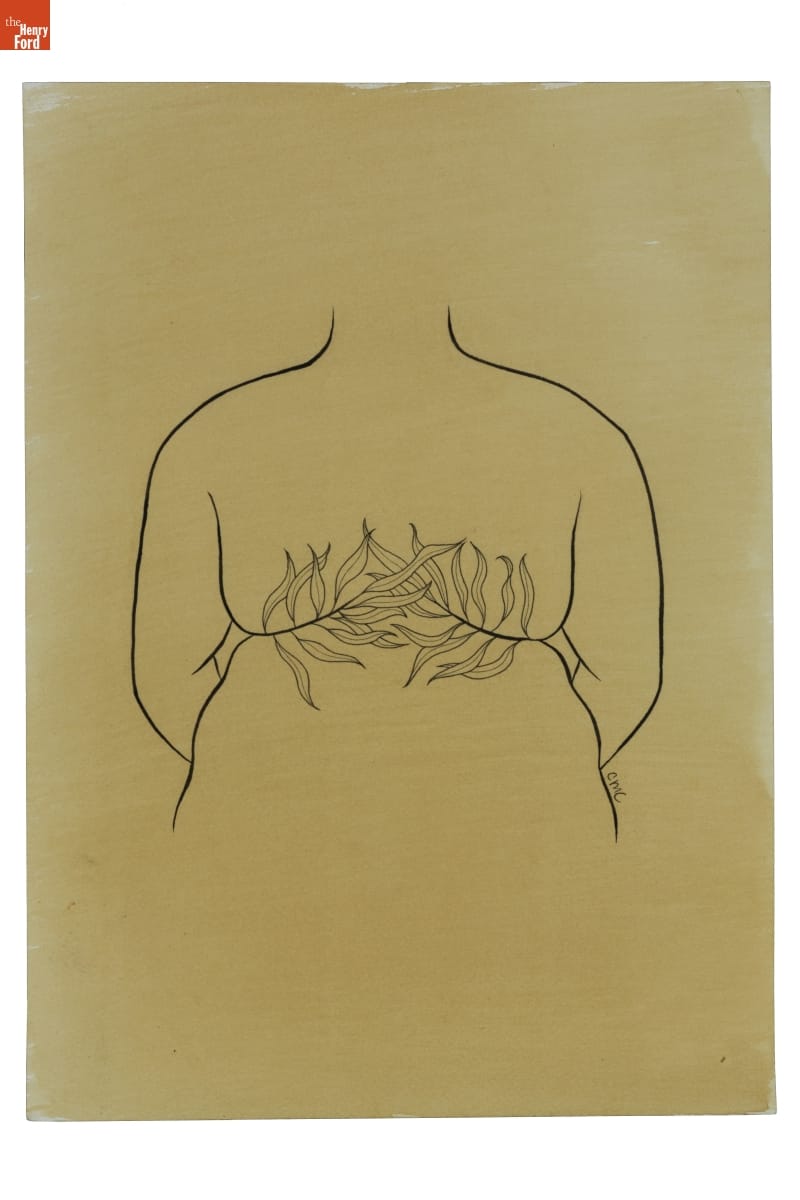
THF190489
These signature “roll flower” tattoo flash designs were drawn and donated by Metz-Caporusso to The Henry Ford. In 2022, The Henry Ford commissioned Metz-Caporusso to create illustrations for apparel, which will soon be available in museum stores. 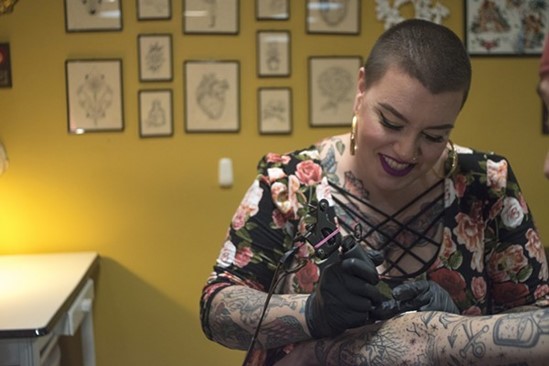
Photo courtesy of Carrie Metz-Caporusso
Mother of the Movement
Marsha “Pay It No Mind” Johnson was a New York City–based drag performer and activist who identified as a gay transvestite (the term transgender was not used at that time).
She was tireless in her advocacy for gay rights. From the mid-1960s on, she was an active presence—often a mischievous instigator—at almost every major uprising, parade, and political action connected to the LGBTQ+ equality movement. She clashed with police during the Stonewall Uprising, helped create the Gay Liberation Front, and participated in AIDS awareness group ACT-UP. With Sylvia Rivera, Johnson was a “house mother” for the Street Transvestite Action Revolutionaries—a political collective and homeless shelter for trans youth of color. Johnson died under suspicious circumstances in 1992—believed by many to be a victim of anti-gay violence.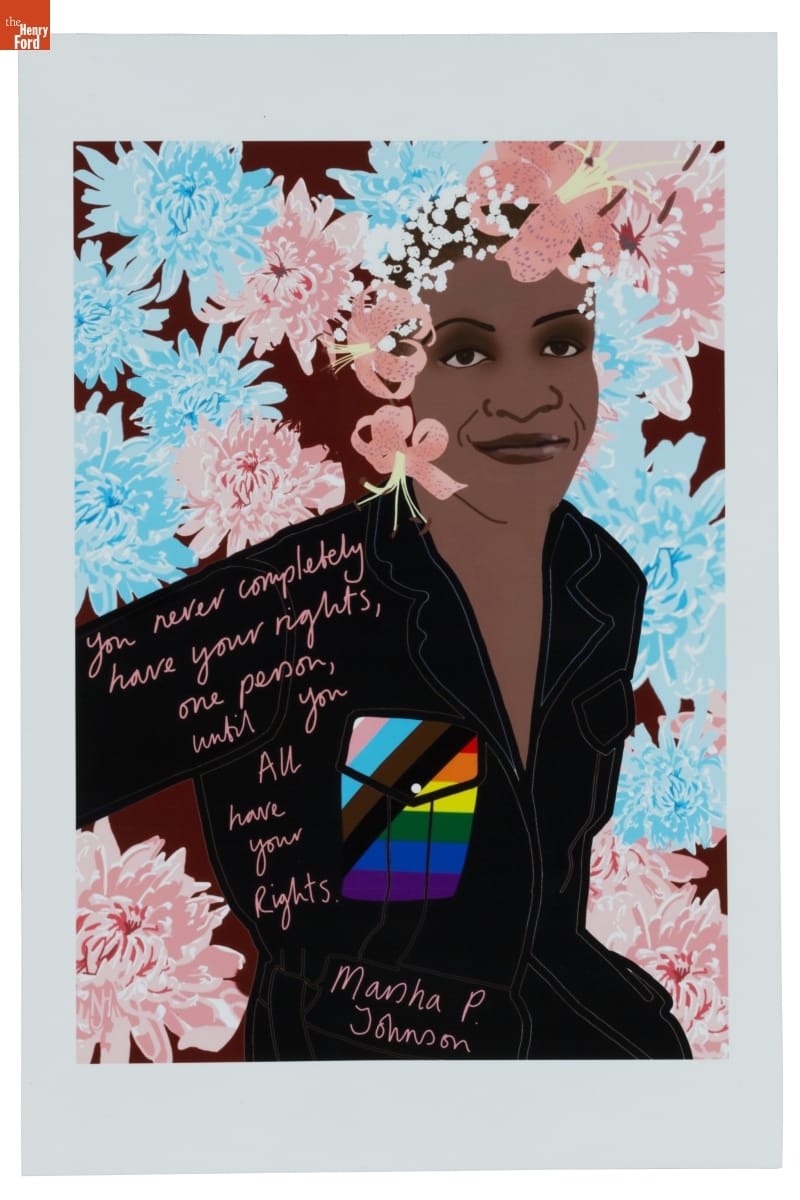
THF190491
This print, created by Julia Feliz in 2018, honors the intersectional legacies of Black LGBTQ+ leaders, as well as Daniel Quasar’s redesign of the Pride Flag to include stripes for BIPOC (Black, Indigenous, and people of color) and trans people.
Listening to the Community
The stories and lives represented in this exhibit just barely scratch the surface of what it means to be LGBTQ+ in the United States. Visibility often increases vulnerability—and backlash. Bigotry, discrimination, and social justice issues related to equal rights and access continue to impact LGBTQ+ people around the world.
Kristen Gallerneaux, Curator of Communications & Information Technology at The Henry Ford, and Katherine White, Associate Curator at The Henry Ford, collaboratively produced this exhibit and blog.
Henry Ford Museum, by Katherine White, by Kristen Gallerneaux
Old Faithful Inn: The Essence of Rustic

The photograph I came across in The Henry Ford’s archives in 1985. / THF120353
Back in 1985, I was looking through The Henry Ford’s archives for images that depicted vacation destinations to complete a museum book I was writing called Leisure and Entertainment in America. There, in our collection, I came across the most amazing photograph of a hotel that I had ever seen. It looked like the outdoors had been brought inside. A great lobby dominated the scene, featuring a mammoth fireplace made of massive boulders. Real, full-size logs supported the balconies that rose several stories. In the midst of all this grandeur, comfortable Mission-style rockers, settees, and handwoven rugs were scattered about.
What was this place? I wondered. Did it still exist? Could I go there?
This was my first encounter with the Old Faithful Inn, which is situated alongside Yellowstone National Park’s most famous geyser, Old Faithful. As it turns out, Old Faithful Inn is quite significant in its own right, as it was not only the first rustic hotel of the Western national parks, but it also set the standard for rustic lodgings and manmade structures in other national parks.
What was the story behind this unique place?
Photographs like this one of Yellowstone Lake, from the 1870s, encouraged early tourism in the park. Note the man fishing, lower left. / THF120349
During the first few decades after Yellowstone became a national park in 1872, accommodations inside the park were, admittedly, spotty. The small number of well-to-do tourists who could afford the trip to Yellowstone during this time expected the pleasures of the high-class, comfortable lodgings they were used to on their European vacations or nearer to home along the East Coast. The first lodgings near Old Faithful were generally ramshackle establishments, built quickly and cheaply. When a lunch station/hotel constructed there in 1884—nicknamed “The Shack”—burned down, park administrators were actually relieved. They had considered it an eyesore.
Before the Old Faithful Inn existed, the Fountain Hotel—typical of Yellowstone hotels at the time—provided comfortable lodging 10 miles north of Old Faithful. / THF203310
Tourism increased when the Northern Pacific Railroad established the “Grand Tour” route through the park for four- to five-day horse-and-carriage tours. At key stops like Mammoth Hot Springs and Yellowstone Lake, the railroad had built some of the nicer hotels in the park. But Old Faithful was located 10 miles south of the route, and comfortable lodgings were already available at the privately-run Fountain Hotel near the Paint Pots (bubbling mud pots) thermal feature. Railroad executives were reluctant to take a chance on building a hotel so far off the beaten track.
Old Faithful was such a dramatic attraction, it is surprising that it was not part of the original Grand Tour route. / THF120359
But, in 1894, park administrators passed a special regulation that lodging could be situated ⅛ of a mile from Old Faithful geyser rather than the usual ¼ mile required between lodgings and natural features. This changed everything. Within a few years, Harry W. Child, entrepreneurial president of the Yellowstone Park Association (which oversaw the Northern Pacific Railroad’s transportation and lodgings), began making plans to build a respectable hotel at Old Faithful. He initially engaged Seattle-based architect A.W. Spalding, who designed a hotel much like the other Yellowstone hotels that were reminiscent of European and East Coast hotels. Spalding’s design was never built, as it apparently did not meet the expectations of railroad executives.
The Saranac Inn, a rustic lodging on Upper Saranac Lake in the Adirondacks. / THF126056
It was then that Child turned to his young friend—self-taught San Diego-based architect Robert Reamer—to design something more in the manner of rustic “great camps” of the Adirondacks. Combining the influence of California bungalows (especially the idea of bringing the roofline low to the ground) with the rustic trappings of the Adirondack lodge, Reamer designed a hotel that was radically different from anything seen before but seemed to perfectly fit Yellowstone’s exotic setting.
As seen in this 1908–1909 postcard of the front porch, locally obtained lodgepole pines were used for the ground floor of the Inn, while rhyolite rock (which can be glimpsed in the background) formed much of the building’s foundation. / THF120292
Reamer’s design was completed and approved in 1902, and actual construction of the building began in June 1903. It took 13 months to complete, over a long winter that was particularly bitter. About 40 skilled artisans were hired for the work, hailing from nearby Montana towns like West Yellowstone, Gardiner, and Livingston. They were a hardy crew, facing many hardships while making swift work of the construction. Materials were mostly obtained nearby, including lodgepole pine and rhyolite rock (an unusual type of rock produced by Yellowstone’s volcanic eruptions). A temporary sawmill was built eight miles to the south to produce the many boards of lumber needed for the project. A Livingston, Montana, blacksmith named George Colpitts and his assistants hand-forged the wrought-iron work for Old Faithful Inn, including the massive front door hardware, the fireplace clock and tools, and all the original guest room door numbers and locks. The total cost of construction was $140,000.
Original façade of Old Faithful Inn, 1905, before the east and West Wings and the extended front porch were added. / THF120361
When it opened on June 1, 1904, Old Faithful Inn was a dramatic tour de force. It seemed rooted in the landscape, as if it had risen directly from the earth. On its exterior, the steep gable roof dominated (for both aesthetic reasons and the very practical one of having to withstand 20-foot drifts of snow in winter). Cedar shingles covered the roof and upper siding, with dormer windows that seemed to pop out in odd places (some were real, others just decorative). The building’s interwoven log construction not only gave it a look of permanence and solidity but also transformed it, in essence, into a gigantic log cabin.
Postcard of the great hall lobby, 1904–1905. / THF120294
Inside, the great hall rose 76½ feet—seven stories in all—with square and diamond windowpanes that filtered light in. Upright poles and beams supporting each balcony were made from lodgepole pine tree trunks, with thick branches attached to the trunks at Y-shaped angles. Balconies and stairways were supported by smaller pine branches found around the area, adding interest with their twisted, curved, and gnarled shapes. A trapeze-like wooden platform near the ceiling of the Inn, called the “Crow’s Nest,” originally held a string quartet—who performed before dinner so guests could mingle, and after dinner when the lobby was transformed into a dance hall. (The Crow’s Nest unfortunately closed when it was deemed unstable after a disastrous earthquake in 1959). The fireplace dominated: 15 by 15 feet at its base, with eight hearths, and rising to a tapered pyramidal shape of 41 feet high. Near the top of it was a huge 14-foot windup clock designed by Reamer. Electric fixtures simulating candlelight were placed discreetly around the space.
Postcard of the dining room at Old Faithful Inn, 1904–1905. / THF120296
Behind the great hall was the dining room, with split logs covering an open-pitched roof. Similar to the great hall, it was also dominated by a massive stone fireplace. Guests originally sat at long, family-style tables and could obtain a meal for 75 cents. A dinner bell atop the Inn’s rooftop summoned guests to dinner.
A typical room for lodgers in the Old House, circa 1905. / THF120355
The lobby and upper mezzanines were filled with Mission-style tables, settees, rockers, desks, and Old Hickory tables and chairs. (Old Hickory was a Martinsville, Indiana, company founded in 1892 that specialized in rustic furniture made out of hickory, with woven, hickory-rushed seats and backs.) One hundred forty log-walled rooms for lodging led off the great hall, on two floors, to the east and to the west. Rooms were furnished simply, with brass, iron, or wood beds; natural wood dressers, chairs, nightstands, and desks; and washstands with chamber pots. Some had cushioned window seats. The rooms had steam heat and sinks with running water (communal bathrooms were, and still are, available down the hall.) This original set of rooms, which cost four dollars per night to lodge in when the Inn opened, became known as the Old House.
It is believed that Harry Child’s wife Adelaide (or Addy), who accompanied her husband on the initial trip to hire Reamer, had a hand in the furnishings, decorations, and details. The delicacy of the balconies, stairway railings, window placements, and Mission-style furniture shows her influence. As a result of this collaboration, both men and women felt comfortable and relaxed here. The Inn, in essence, neutralized gender and class distinctions, encouraging impromptu encounters and informality.
The radically different look of Old Faithful Inn prompted the National Pacific Railroad to justify it in its promotional materials. / THF120290
Old Faithful Inn was different from the usual lodging, and Northern Pacific Railroad promoters figured they had better explain this to potential guests. They wrote this statement in the Inn’s defense when it first opened, just in case guests rejected the notion of a rustic hotel: “The Inn is not in the least a freaky affair…. It is a thoroughly modern and artistic structure in every respect—modern in its appointments and artistic in the carrying out of an unconventional and original scheme.”
They needn’t have worried about guests’ reactions. Old Faithful Inn was an immediate hit with the public. One guest, a Mrs. E.H. Johnson, in 1905, recounted: “And then we came to the Inn, the most unique and perfect place; it is the craftsman’s dream realized. My room alone is a paradise of restfulness though in a rough and rustic fashion…. At luncheon we had another treat. The dining room has its own charm.”
Old Faithful Inn after the new porch and veranda were completed in 1927. / THF120323
Old Faithful Inn was so popular, in fact, that in 1913–1914, 100 guest rooms were added to create the East Wing. And, in 1927, with the increasing number of tourists coming by automobile, 150 more rooms were added to create the West Wing. Although the interiors of these later rooms were more modern than those in the Old House, a consistent look was maintained on the exterior for an overall cohesive effect. A covered porch was added to the front of the building in 1927—again to accommodate automobile traffic—with an open veranda above for viewing Old Faithful eruptions. (For more on the impact of automobiles on the national parks, see my blog post, “Automobiles Enter the National Parks.”)
The rustic Lodge, shown on this Bryce Canyon pennant, was constructed in 1925. / THF239283
Old Faithful Inn really started something. The railroad companies, who had made the Western national parks accessible and controlled many of the concessions in the early parks, realized that the rustic style suited these places, and the style spread quickly—first to the upscale hotels, then to other manmade structures in the parks. The National Park Service, formed in 1916, eventually chose the rustic style as its standard architecture across the entire park system. This style, which colloquially became known as “Parkitecture,” reached its culmination with the Depression-era projects of the Civilian Conservation Corps.
Old Faithful Inn was a very atypical hotel of its era. Most resort hotels at the time were intended to serve as civilized oases from the wilderness. Old Faithful Inn, the first rustic-style lodge of the West, was designed to fit in and become part of the wilderness experience. Somehow, Robert Reamer recognized this when he created what was truly a one-of-a-kind national park lodging.
Snapshot of the author at Yellowstone National Park in 1985, standing on the Upper Geyser Basin trail with Old Faithful Inn in the background. / Photo courtesy of Donna Braden
Soon after I first viewed the image of the Old Faithful Inn lobby in 1985, my husband and I had the pleasure of visiting Yellowstone National Park, and we stayed at the Old Faithful Inn. Eighty years after that photograph was taken, it was like we had entered it in real life. We stayed in one of those tiny, log-walled, chamber-potted rooms in the Old House. It was noisy but thrilling to be in that room—to become part of that place. We returned to Yellowstone National Park in 2014, almost 30 years later, and have returned year after year since then (except in 2020 because of the COVID-19 pandemic). We have stayed at the Old Faithful Inn every year—in the Old House, the East Wing, and the West Wing. We plan to stay there again when we return to Yellowstone National Park this summer. Somehow, it always feels comfortable, welcoming, and timeless—like we’re coming home.
Snapshot of the author at West Thumb Geyser Basin, Yellowstone National Park, 2014. / Photo courtesy of Donna Braden
Donna R. Braden is Senior Curator and Curator of Public Life at The Henry Ford.
Yellowstone National Park, travel, postcards, nature, national parks, hotels, by Donna R. Braden

